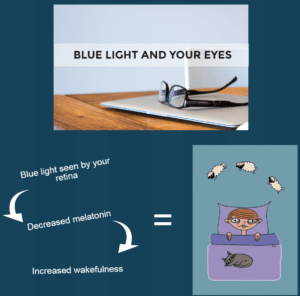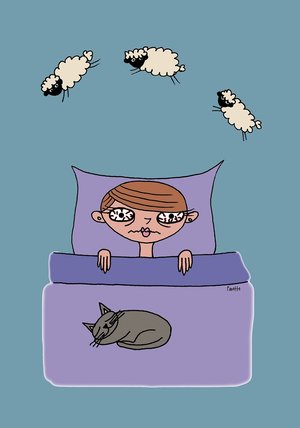Blue light seen by your retina may have detrimental effects on your sleep.
It’s not unusual for me to spend the last few hours of my day reading on my iPad or iPhone. It helps me unwind from a long day and keeps me up-to-date on the latest news. I wouldn’t be surprised if many of you do the same thing before heading to bed. Have you ever wondered whether this habit could be making it harder for you to fall asleep and stay asleep through the night?
A lot has changed in light technology over the last few years. Gone are the days of the Edison light bulb you learned about in grade school. Americans have become dependent on smartphones, tablets, and other techie gadgets which utilize light emitting diodes (LEDs) to allow you to view their content. This technology has led to the increase in light emitting devices in the bedroom. If you are like me, most of your reading is now done on a tablet rather than a physical book. Below, we will discuss if all this light prior to bedtime is good for your sleep.
Let’s first discuss light more generally. Although humans perceive visible light as predominantly white, remember that light can be broken down into its component colors of red, orange, yellow, green, blue, indigo, and violet. This is the phenomenon that explains rainbows. The different colors correspond to varying wavelengths of light. Violet light has the shortest wavelength and red light has the longest. Scientists and ophthalmologists think that perhaps the blue wavelength of light emitted by electronic devices may be the culprit in the disruption of normal sleeping patterns [1]. Your eye detects the blue wavelength of light through small cells in your retina called ganglion cells. A pigment in some of your ganglion cells called melanopsin is particularly sensitive at absorbing this specific blue wavelength of light [1].
The theory is that smartphones and tablets, both of which emit blue light, can confuse our brains and decrease the body’s natural production of melatonin. Melatonin is a hormone produced by the pineal gland in the brain that helps regulate a person’s circadian rhythm or sleep-wake cycle. It is normally low in the mornings and elevated in the evenings- which helps us to fall asleep. A decrease in the body’s production of melatonin can make it difficult to both fall asleep and stay asleep during the night. This, in turn, can result in decreased cognition, worsened mood, and depression. Some people are very sensitive to alterations in their sleep cycles.

Despite what we know about the relationship between melatonin and sleep, the relationship between your iPhone and your circadian rhythms is less clear. There has been debate among scientists, particularly ophthalmologists, about how blue light (or light in general) really affects patients and normal sleep rhythms.
It does seem clear to me that heavy use of electronic devices, in general, is associated with poor sleep. A large study in 2012 in Norway looked at 9846 adolescents between the ages of 16-19. The study looked at many variables including bedtime, time in bed, sleep duration, and sleep onset latency. Nearly all children reported using an electronic device in the hour prior to sleep. The most common devices were personal computers and cell phones. The use of any electronic devices at bedtime was associated with increased odds of sleep onset latency, or the period of time from full wakefulness to sleep. Total screen time above 4 hours per day was associated with an increased risk of sleeping less than 5 hours per night. The authors concluded that there was a negative relationship between the use of technology and sleep and suggested that recommendations for healthy media use needed updating [2].
Another study in 2015 specifically looked at the blue light issue. The study authors used blue light filtering glasses in 15-17-year-old adolescent boys. The glasses proved helpful in blunting the melatonin suppression that occurs when looking at a computer screen. Wearing blue filtering lenses allowed the boys to feel sleepier and less vigilant prior to bed [3].
After reading these studies, I decided to make a couple of changes to my nightly reading ritual. In addition to trying to read print books rather than e-books prior to bed, I have begun to use the “Night Shift” feature on my iPhone, which adjusts the display and causes the iPhone to emit less blue light. This feature was included in the iOS 9.3 software update for the iPhone and iPad. Similar applications are now available on the Android line of phones.
The jury is certainly still out on blue light and its effects on the retina and your sleep. Although scientists do not yet know definitively whether blue light negatively impacts sleep, reducing the amount of blue light reaching the retina at night may be beneficial. If you have been having difficulty falling asleep or staying asleep throughout the night, consider making a change to your nighttime routine and avoid using electronic devices close to bedtime.
Note: Here are instructions on how to set up the Night Shift feature on your iPhone. Get this app if you have an Android device. I have no financial interests in either product.
Now, time for a nap.

